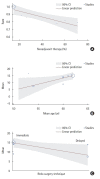Outcomes of redo for failed colorectal or coloanal anastomoses: a systematic review and meta-analysis
- PMID: 36535708
- PMCID: PMC10626334
- DOI: 10.3393/ac.2022.00605.0086
Outcomes of redo for failed colorectal or coloanal anastomoses: a systematic review and meta-analysis
Abstract
Purpose: This study aimed to review the outcomes of redo procedures for failed colorectal or coloanal anastomoses.
Methods: A systematic review was performed using the PubMed, Embase, Cochrane, and LILACS databases. The inclusion criteria were adult patients undergoing colectomy with primary colorectal or coloanal anastomosis and studies that assessed the postoperative results. The protocol is registered in PROSPERO (No. CRD42021267715).
Results: Eleven articles met the eligibility criteria and were selected. The studied population size ranged from 7 to 78 patients. The overall mortality rate was 0% (95% confidence interval [CI], 0%-0.01%). The postoperative complication rate was 40% (95% CI, 40%-50%). The length of hospital stay was 13.68 days (95% CI, 11.3-16.06 days). After redo surgery, 82% of the patients were free of stoma (95% CI, 75%-90%), and 24% of patients (95% CI, 0%-39%) had fecal incontinence. Neoadjuvant chemoradiotherapy (P=0.002) was associated with a lower probability of being free of stoma in meta-regression.
Conclusion: Redo colorectal and coloanal anastomoses are strategies to restore colonic continuity. The decision to perform a redo operation should be based on a proper evaluation of the morbidity and mortality risks, the probability of remaining free of stoma, the quality of life, and a functional assessment.
Keywords: Colorectal neoplasms; Colorectal surgery; Reoperation; Surgical anastomosis.
Conflict of interest statement
No potential conflict of interest relevant to this article was reported.
Figures







References
-
- Westerduin E, Borstlap WA, Musters GD, Westerterp M, van Geloven AA, Tanis PJ, et al. Redo coloanal anastomosis for anastomotic leakage after low anterior resection for rectal cancer: an analysis of 59 cases. Colorectal Dis. 2018;20:35–43. - PubMed
-
- Salomé GM, de Almeida SA, Silveira MM. Quality of life and self-esteem of patients with intestinal stoma. J Coloproctol. 2014;34:231–9.
-
- Westerduin E, Klaver CE, van Geloven AA, Westerterp M, Bemelman WA, Tanis PJ. Outcome after redo surgery for complicated colorectal and coloanal anastomosis: a systematic review. Dis Colon Rectum. 2018;61:988–98. - PubMed
-
- Maggiori L, Blanche J, Harnoy Y, Ferron M, Panis Y. Redo-surgery by transanal colonic pull-through for failed anastomosis associated with chronic pelvic sepsis or rectovaginal fistula. Int J Colorectal Dis. 2015;30:543–8. - PubMed
Publication types
LinkOut - more resources
Full Text Sources
Miscellaneous

